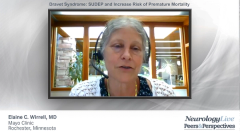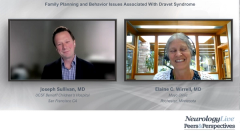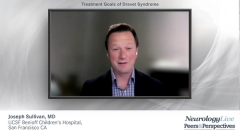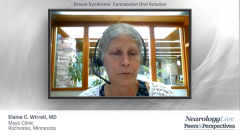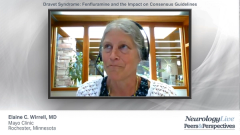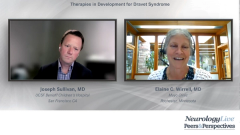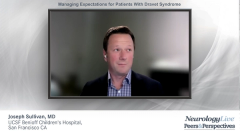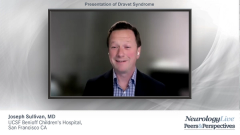
Recent Approval of Fenfluramine Oral Solution
Joseph Sullivan, MD, provides an overview of the recent approval of fenfluramine oral solution for the treatment of Dravet syndrome.
Episodes in this series

Joseph Sullivan, MD: It highlights the importance, again, of the specific syndrome diagnosis because it really was our patient community that was reaching out for these cannabinoids, I should say and that gave almost preliminary data to say, this is worth exploring and think a very similar story followed with fenfluramine. It was observations in a small cohort of patients who, at the time, weren’t even known to have Dravet syndrome. But just looking back at some of the commonalities in terms of this pattern or photosensitivity and pattern sensitivity to sort of stumble upon, “Wow, this may have a specific role in Dravet syndrome.” I remember it was at one of the first international epilepsy meetings that I was fortunate to go to in Rome, [Italy], and it was when the initial data was presented about the small Belgian code. I think it was in 2016, and I was like, “Well, that’s great but, how can I get it?” Because at that point in time it was only royal decree in Belgium that you could get it. Short of picking up and moving to Belgium, it was great news, but thankfully, things moved forward, and the compound went into the same rigorous phase 3 clinical trials. There was a lot of I think concern around, is this going to be very, very effective, but is it going to be plagued by some of the cardiac valvular observations that happened when it was used as part of a weight-loss regimen back in the 90s.
I’ll just quickly summarize what we saw in those trials. Again, phase 3 double-blind placebo-controlled trial, looking at a couple of different doses—the 0.7 milligrams per kilogram dose and a lower dose of 0.2 milligrams per kilogram. Again, those doses were largely chosen based on the small 10, 12 patients that were treated by the original Belgian physicians and then a placebo arm. Thankfully, at the end of that placebo-controlled phase when everything was unblinded, the 50% responder rate was 70%. So 70% of patients experienced a 50% reduction in seizures or more, and you can imagine so 70%. Well, what about those that they did even more than 50% reduction? For the first time, I think in a long time, we were able to see a 75% so-called responder rate with almost half of the patients achieving that. If you sort of think about how that, and then the placebo was significantly lower and then lastly, again, you’re kind of getting greedy. Well, 75%, what about 100%? How many are seizure-free? Well, seizure freedom, I think is still such a high bar because this may seem like a silly statement, but once you have one seizure, you can therefore not be seizure-free again. At least in that time period that you’re studying. So we looked at what we term near seizure freedom—having either no seizures or a single seizure during that 14-week trial, and if you lump together the low dose and the high dose 25% of patients actually achieved that outcome. Now, I feel we’re setting the stage for what is possible. Getting back to 3 months of seizure freedom and only 10% of patients, now we’re pushing that up a little bit to 25% was just so refreshing to see and experience as an investigator in the trial to have some of these patients come in and be like, “What do you mean you haven’t had. Really? Can I look at your diary again? You haven’t had a seizure?” It was really, really exciting. I’m wondering when you saw these kids coming in beyond seizures, did you see other things in them where we finally get to see them not getting rescue meds and having these frequent seizures that they’d been having?
Elaine C. Wirrell, MD: I think so much about quality of life and Dravet is related to seizures and breakthrough seizures and prolonged seizures. I think that’s a very negative impact on quality of life both for the kids and the families. I saw these kids actually being able to be kids and being able to get to school more often and participate in family activities more often. Families were getting better sleep. They certainly appeared better rested. So I think certainly improvement and alertness in the kids with less seizures. I think we have seen that even more as we’ve been able to. Then, if you’re in a placebo-controlled trial you can’t touch the other medications, but if a medication works and then we can get you off some of those medications that you were on that were giving you more side effects, but maybe weren’t working as well then we really start to see these kids become more alert and quality of life improves. So absolutely that’s a big impact.
Joseph Sullivan, MD: As you mentioned, when you’re in one of these clinical trials, you’re stuck on not making any changes and we put these kids and their parents and caregivers through all these other assessments to try and make sure that the drug is safe and we want to understand if it’s well-tolerated and so they had echocardiograms because of the prior history. We did all these developmental sorts of questionnaires, mainly again, to ensure that it was safe because if someone is put to sleep and on the couch or their behavior falls apart, but their seizures improve, that could be a negative outcome for these families. Thankfully, the safety profile was very favorable. There still has not been any cases of valvulopathy seen in any patient. There was decreased appetite, which we went into this expecting because it was part of a weight-loss drug. But, thankfully, the majority of the time that is self-limiting and, in my experience, it comes back, and the kids continued to gain weight as we would expect them to. And this development of being more alert, I mean this safety measure that was put in there, the brief survey really showed that not only did it not decrease their behavior, or worsen their behavior and executive function, but in those patients that actually responded, a subset of them had clinically meaningful and clinically significant improvements in their brief. So again, this was like the first time that we started to see, “Maybe if we can get,” and I think the family said this, “if we can just…I know Johnny is in there. If we can stop. If we can reduce the seizures, it’ll allow him to thrive.” And I think we’re starting to see some of that.
Elaine C. Wirrell, MD: Absolutely.
Joseph Sullivan, MD: Thank you for watching this Neurology Live® Peers & Perspectives®. If you enjoyed the content, please subscribe to our e-newsletters to receive upcoming programs and other great content in your inbox. Thank you so much.
Newsletter
Keep your finger on the pulse of neurology—subscribe to NeurologyLive for expert interviews, new data, and breakthrough treatment updates.


